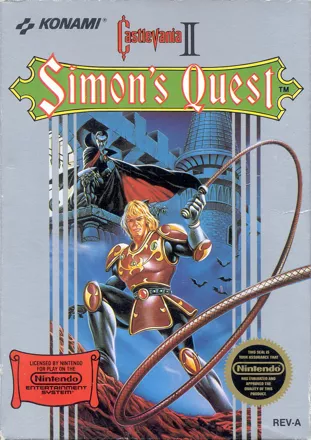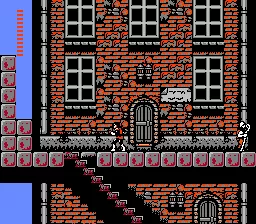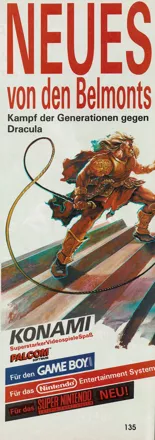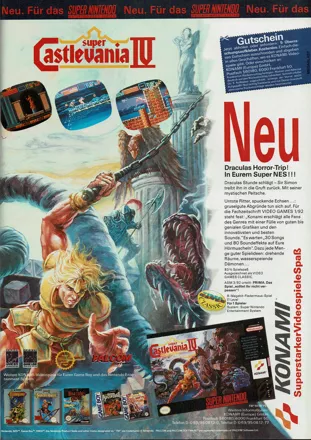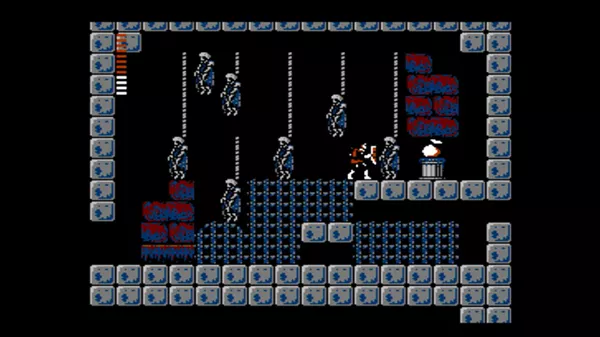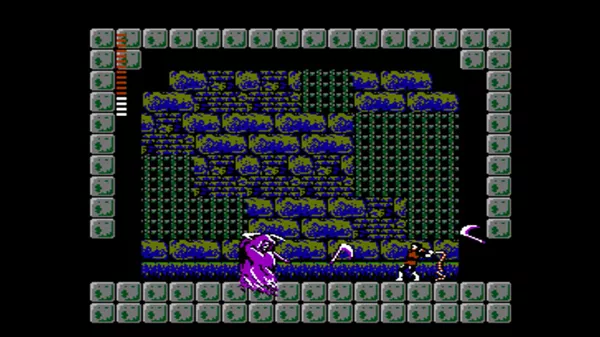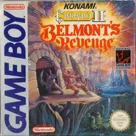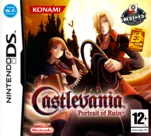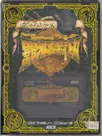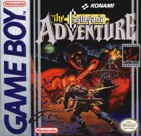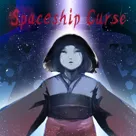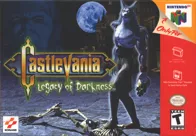Castlevania II: Simon's Quest
- Castlevania II: Simon's Quest (1989 on Dedicated handheld)
Description official descriptions
Castlevania II: Simon's Quest is the second game in the Castlevania series. After the vampire killer Simon Belmont destroyed Count Dracula in the previous game, an evil curse possessed him. The only way Simon can break the count's curse is to find five of Dracula's body parts (which are mysteriously strewn throughout Transylvania) and burn them.
Gameplay-wise, Simon's Quest is quite different from its predecessor, combining side-scrolling action and platforming with strong role-playing elements. The game does not feature the traditional stages but allows the player to freely roam the land of Transylvania in the style of Nintendo's Metroid. The game world is divided into outdoor areas, dungeon-like mansions containing crucial quest items, and towns, where Simon can talk to non-player characters, rest, and buy items in shops. Some areas can only be accessed by equipping and using specific items that must be bought or found.
The RPG elements are present in character growth, monetary system, and weapon upgrades. Simon's initial whip can be replaced by more powerful variants that can be purchased in various towns. Hearts are used as currency in the game and are obtained from defeated enemies in different quantities. The same hearts also function as experience points: after Simon has accumulated a set amount, he levels up and his attributes are increased.
The game features a day and night cycle that occurs at accelerated pace in real time. At night, enemies inflict more damage, but also drop more hearts upon defeat. Shops are closed during nighttime, and townspeople are replaced by wandering zombies.
Spellings
- ドラキュラII呪いの封印 - Japanese spelling
Groups +
Screenshots
Promos
Credits (NES version)
12 People
| Invincibility |
|
| Permanence |
|
| Philosophy |
|
| Masterpiece |
|
| Sensitivity |
|
| Excellence |
|
| Ambivalence |
|
| Flourish |
|
| Admiration |
|
| Superiority |
|
| Synchronism |
|
| Circumstance |
|
Reviews
Critics
Average score: 68% (based on 27 ratings)
Players
Average score: 3.4 out of 5 (based on 115 ratings with 8 reviews)
This is what NES value games were all about
The Good
The game had a lot of variability which was cool for a game of that era. You build your character a-la Metroid, Zelda and Mega Man; in a style that was not resurrected in the Castlevania Franchise until the immensely popular Symphony of the Night on PS1. This game was way ahead of the franchise time; but ultimately proved to be the granddaddy of modern Castlevania in my opinion. The day and night conditions and free-roaming gameplay are a cut above the rest, not showing up until later titles such as Ocarina of Time.
The Bad
1.) Simon doesn't look like the guy on the cover! Since when is brown hair blond? And why is Dracula waiting for Simon when Simon has to put him back together? The packaging for this game sucked and I bet that's why a lot of you apparently missed it.
2.) While I was ultimately very satisfied with the game; the ease of defeating Dracula and the subsequent death of the hero (in a very brief ending; one of 3 possible endings -- another novel feature of this classic); was mildly disappointing to the eight year old reviewer at time of completion.
The Bottom Line
One of my favorite NES games of all time and something I would recommend as a predecessor to many of the video game innovations that we still want developers to incorporate.
NES · by Mike Hotch (2) · 2006
A nice Castlevania action-RPG sequel
The Good
Back in 1986, Konami released Castlevania on the NES. It was a hugely successful game that was ported to other home systems such as the Amiga, Commodore 64, and PC. The game came in two forms. Most NES users back in the day would be familiar with the cartridge version; but those who lived in Japan could also obtain the Famicom Disk System (FDS) version. Each version has its advantages and disadvantages.
Simon Belmont was on a quest to put an end to Dracula’s reign; but unfortunately for him, the Prince of Darkness placed a curse on Simon in his final minutes, although the player was not made aware of this fact at the end of the first game. This curse will send him to an early grave unless he resurrects Dracula, but it can be lifted if he manages to recover eight of Dracula’s limbs scattered around in Transylvania and burn them. To make matters worse, monsters are out rampaging the land and terrorizing its inhabitants.
Konami wanted to do something different with the franchise, by mixing platforming and role-playing elements, similar to the likes of Metroid and Zelda II. This comes apparent when you explore seven towns, where you interact with the townspeople and buy items that help you throughout the adventure. The townspeople will give you hints on what to do. I suggest writing down these hints in case you forget. Each town consists of two floors (some with a platform in between) and have their own color schemes. There are also mansions which you need to get through in order to retrieve one of Dracula’s limbs, which are essential in completing your quest. For example, you have to present the Ferryman with a limb to make him get you across a large body of lava in his boat.
In between the towns and mansions, you have to negotiate rivers, forests, and graveyards, defeating monsters. The backgrounds contain a mixture of dark blue, dark gray, and sepia tones that blends in with the game’s horror setting. Defeating a monster causes it to drop a heart that awards Simon with cash. The monsters boast good animations and they behave the same way they do in the first game. Your health is decreased every time you are attacked by a monster, but it can be replenished by entering churches that are in town. As with any other NES game out there, losing all your energy results in a loss of life, and it is game over if you run out of lives. You can still continue the game if you enter a password given to you on the game over screen. (Lucky FDS users can save their progress instead.)
I like how Konami got creative with this game. It starts off with the title being presented in a huge negative that scrolls to the right to reveal the prologue, and pressing Start allows you to go to the options screen, all the while listening to some spooky music. The password input screen is beautifully presented. It depicts a brick wall with two huge windows showing mountains. At the front are three panes showing the relevant information.
Castlevania II is one of the first NES games to offer a day/night cycle. The flow of the game is unaffected, but how long you take to complete the game determines which of the three endings you will view at the end of the game. At night, shops and churches are shut, the townspeople are transformed into hideous monsters, and the monsters themselves are difficult to beat. At any time during the game, you can press the Start button to pause the game and view useful information such as time (measured in Days:Hours:Minutes), level, experience rating, number of hearts, and the type of whip, although Konami could have provided this information on the main screen. It is also here that your inventory can be accessed. Although it can be annoying that you can’t purchase items at night, it gives you a good reason to keep slaying enemies to make loads of money.
The music in the game is brilliantly composed by Kenichi Matsubara, and most of the soundtracks are memorable. The spooky night soundtrack blends in with the horror setting. I like the tune that plays when you are in the final mansion. The sound effects are quite similar to the ones from the first game. The soundtracks are slightly different between the two versions, with an extra sound channel provided for the FDS version; this was removed for the cartridge version.
Castlevania II can be played again; not just to experience the multiple endings, but to seek out the alternate routes the game provides. The endings share the same picture but each one contains different text. The fifteen-page manual for the game is well illustrated and goes into great detail about everything.
The Bad
I share the same concerns as The Angry Video Game Nerd, and one of them is the kickback that you receive when you are hit by an enemy; this is quite bad when it happens near water or lava. Imagine how angry you would feel if you are trying to jump on a narrow platform, only to have an enemy come out of nowhere and knock you in a body of water.
Also, the transition between day and night is annoying. A dialog box appears above you, and you can’t do anything.
The Bottom Line
I enjoyed playing through Castlevania II myself. I like to think of it as Zelda II, minus the overhead map. There are enemies to kill, items to buy, and people to interact with. Although I complained about the game not providing enough information on the main screen, the numerous remakes of the game address this. The graphics and sound are relevant to the horror setting, and the multiple endings are an incentive for fans to play the game again.
Konami wanted to do something different with the gameplay this time, but its poor sales made them go back to the original formula.
NES · by Katakis | カタキス (43091) · 2021
Simon's Quest: Non-Linear! RPG-Puzzles! Engrish!
The Good
Castlevania II: Simon's Quest (Simon's Quest) for the Nintendo Entertainment System (NES) is one of those great NES games that could break up friendships.
In designing this sequel, the developers opted for an adventure or role playing game-style, which people tended to love or hate with a deep passion
Nintendo did a similar thing with Zelda II, a game that is not as polarizng among Zelda fans as Simon's Quest is among Castlevania fans.
For better or for the worse, the “haters” of Simon's Quest won the day, because subsequent Castlevania games returned to the original, action-packed, blistered thumbs game-play style.
However, I am one of these people (perhaps in a minority) who actually enjoyed the changes seen in Simon's Quest.
This is not to say that I “hated' the arcade style of Castlevania or its sequels. However, as someone who does enjoy role playing and adventure games, it was refreshing to see these elements used in a home console game.
Most of the really great role playing games were only accessible – especially without censorship – through the original computer edition or Japanese imports.
Likewise while some great adventure games were designed for the PC and Mac, few of them ever made the jump to the home console sytems.
I am not saying that hack and slash, arcade action isn't fun, but it was only a small slice of what the gaming industry was doing throughout the 1980s and 1990s.
Maybe this is not a complaint widely shared, but it is my opinion and I am sticking to it. Now that I have dealt with the love-hate relationship attached to this game. Let us get back to Simon's Quest game itself.
Simon's Quest combines side-scrolling arcade game with some traditional role-playing or adventure gaming elements.
Instead of linear stages, the game presents a large world to explore, with both night time and daytime elements. The player has to explore the world, interact with different characters (especially in towns), locate items to solve puzzles as well as upgrades to your weapons.
Simon needs to improve his strength, obtain money and stronger weapons if he is going to succeed in this quest. If you enjoy basic role playing or adventure game elements, then you will enjoy what this game has to offer.
Did I mention the night and day sequences? Well, they are worth mentioned again! Not only does the game actually switch between night time and daytime, but things tend to get creepier at night.
Nighttime means that town shops are closed, as towns are invaded by zombies and, yeah, generally everything gets creepier at night in this game. Frankly, this is probably as close to a horror film as a game for a Nintendo system could get – outside of Japan.
Simon's Quest features improved animation and graphics and players should have little complaints with the hit detection, inventory menu or other such basic game play mechanics.
Simon's Quest does not skimp on the arcade action. Several creepy-looking buildings in the game return the player to side-scrolling action.
Even when you are explore the rustic charm of Translyvania, their are plenty of supernatural creatures – large and small – will have to be killed if Simon is to break the curse.
Ah, the curse! Simon is forced to locate the missing body parts of Dracula, so that he can burn them in the fire – of Mount Doom? No, but someplace special.
Apparently, when Simon killed Dracula the first time, he forget to burn the body, or maybe Simon just didn't know any better.
Granted, one would have thought that a skilled vampire hunter would have known to do this beforehand. It does make you wonder whether or not Simon has the education background needed to fight evil supernatural creatures, without, you know, causing widespread destruction or spreading dangerous curses.
OK, maybe Simon does not need a "license to kill", but I refuse to believe that I am the only Castlevania fan who has wondered if Simon (or his ancestors) is “winging it” a bit more then he should be.
The Bad
Simon's Quest emphasis on adventure role-playing game elements did not sit well with all fans of the Castlevania franchise.
Zelda II pursued a similar format, with much less much criticism, but the first Zelda game had mixed blistered thumbs action with adventure role-playing game elements. The change in style between Castlevania and Simon's Quest is much more significant.
Castlevania is entirely a side-scrolling, arcade action-type game. While Simon's Quest did not totally abandon the side-scrolling elements of its predecessor, it clearly sought to bring fans of adventure role-playing games into the Castlevania franchise.
It was successful in doing so, but many Castlevania fans simply did not want have the franchise turned into an adventure role-playing game (RPG).
These Castlevania fans simply did not want to see the franchise take its cues from Ultima, Zelda or The Secret of Monkey Island. Instead they wanted an arcade side-scrolling game that was heavy on supernatural action and violence.
Fans of RPG or Adventure Games, especially of the non-linear sort, may still have some complaints about the game. Some of the puzzles in the game do not seem to have any clues or have close that got lost in the translation. This bring us to the issue of "Engrish"
Part of the problem is with the English localization or adaption. Translating Japanese text -- often a major feature of pre-CD-ROM adventure RPG games -- into English that is not only legible, but also captures some of the mystery or nuance of the text is difficult.
Language (especially the informal language that most people use in their daily lives or an epic quest) is oftentimes influenced by a nation's culture as much as it is the background and beliefs of the author.
A direct-literal translation of Japanese text to English text is not always appropriate because of the nation's culture and history (and even geopolitics) behind the language.
I seen worse English localization in a NES video game, but not all of the text in Simon's Quest is as translated as well and as smoothly as it could be.
The Bottom Line
Castlevania II: Simon's Quest for the Nintendo Entertainment System seeks to bring fans of adventure role-playing games into the Castlevania franchise, at the risk of alienating fans who expected the sequel to follow the arcade action format of the first game. It is a great game within the non-linear, adventure role-playing genre, but its ability to appeal to gamers looking for side-scrolling action is limited.
NES · by ETJB (428) · 2014
Discussion
| Subject | By | Date |
|---|---|---|
| Also released May 2019, part of Anniversary Collection, including a Windows version. | Andrew Fisher (697) | Jun 23, 2023 |
| Another "black sheep" turns out to be a gem | Unicorn Lynx (181780) | May 30, 2012 |
Trivia
Endings
The game features three different endings, which are activated based on the amount of game-time it took the player to finish the game. The first one is for three days or less, another is for eight days or less and the third is for any time playing over that. The endings are different between the US and Japanese versions of the game. It's debatable which of the three is the better ending (the fastest ending isn't considered the best), however it seems that in two of them, Simon Belmont does not survive the curse Dracula placed upon him.
Famicom Disk System Version
The original Japanese version of the game, named Dracula II: Noroi no Fuuin, was not released on a cart. It was available for the Famicom Disk System, an add-on that lets the Famicom play video games straight from a special floppy disk.
There are some differences between this version and the US one:
- It does not use passwords to record the player's progress, it saves the data to one of three save files on the disk.
- It has different music because the Famicom Disk System has an extra sound channel that was not available via other means.
- The mansion music also plays when the player is at their outside entrances.
- There are some sound differences: the glass-shattering effect of holy water doesn't exist, the sound effect for Simon falling into water is altered, the secret-discovering sound plays only when the player initially talks to hidden souls and not after, and there are snazzier sounds for the Ferryman's actions and the Deborah Cliff tornado-soul ride.
- There are deviations on some names (most notably, Simon's last name in the Japanese version, as is usually the case with the family name, is Belmondo. Also, Camilla Cemetery is instead called Carmilla Cemetery).
- It has a slightly higher enemy rate.
- It's possible to purchase garlic and laurels even after Simon's stock is filled.
Garlic Exploit
In the original Japanese Famicom Disk System-only version of the game, it is possible to beat the last boss using only a single piece of garlic. Doing this really takes a long time though. Just drop a piece of garlic on the floor, move and wait for the boss to hit the garlic. It will be hit 256 times without having the ability to move, then die. In the western cartridge port of the game, Konami made the supply of garlic vanish for the final battle, probably because this trick was well-known in Japan.
Innovations
It was the first game to feature a day/night cycle.
Novel
A 1990 novella based on this game was published by Scholastic as part of their Worlds of Power series for children at risk of losing their literacy to video gaming -- books based on non-Nintendo-owned NES games, all attributed to the author F.X. Nine (though this one is also credited: written by Christopher Howell, a Seth Godin Production). At the ends of chapters, hints for the completion of the video game appear in spoiler-secured upside-down text.
Nintendo Power Controversy
The second issue of Nintendo Power had a cover based on Castlevania II: Simon's Quest. It depicted a man in a suit of armor (probably Simon Belmont) holding Dracula's severed head. The cover prompted several phone calls from mothers who claimed it gave their children nightmares.
The Black Dahlia Murder
The American death metal band The Black Dahlia Murder, used this game as inspiration for their first release, What a Horrible Night to Have a Curse. The title is derived from the phrase "What a horrible night to have a curse" which appears onscreen during transitions from day to night. The song What a Horrible Night to Have a Curse from their third album Nocturnal is a downloadable track in Rock Band, bringing Castlevania to that franchise in a sort of round-about way.
Awards
- Power Play
- Issue 01/1990 - #3 Best Nintendo Game in 1989
Information also contributed by Andreas Vilén, Bregalad, CaptainCanuck, Dracula Marth, Pseudo_Intellectual, ResidentHazard and WildKard.
Analytics
Upgrade to MobyPro to view research rankings!
Related Sites +
-
Castlevania Dungeon
Fansite dedicated to everything and anything Castlevania. -
Howard & Nester do Castlevania 2
A regular feature in Nintendo Power magazine, Howard & Nester was a comic strip about two game whizzes who would one-up each other, while disclosing hints and tips, in the settings of various recently-released games for the NES platform. In the November / December 1988 two-page installment, they figure out how to find Bodley Mansion. -
OC ReMix Game Profile
Fan remixes of music from Castlevania II: Simon's Quest, including the album "Sonata of the Damned". -
Play "Castlevania II: Simon's Quest" online!
The entire game can be played on this website, which uses a Java-based NES emulator called vNES to call up ROMs for its visitors. -
Video review of Castlevania II
The Angry Video Game Nerd, Jame Rolfe, reviews Castlevania II: Simon's Quest. This is Jame Rolfe's first Angry Video Game Nerd review. -
Video review of the Castlevania series (WARNING: Language)
The Angry Video Game Nerd, James Rolfe, reviews games in the Castlevania series. In part 2, he takes a second look at Castlevania II: Simon's Quest and reviews Castlevania III: Dracula's Curse, both on NES.
Identifiers +
Contribute
Are you familiar with this game? Help document and preserve this entry in video game history! If your contribution is approved, you will earn points and be credited as a contributor.
Contributors to this Entry
Game added by Roedie.
Nintendo 3DS, Wii U added by GTramp. Wii added by Sciere.
Additional contributors: Guy Chapman, Foxhack, Pseudo_Intellectual, Echidna Boy, LepricahnsGold, jsbrigo, Cantillon, Patrick Bregger, Thomas Thompson, MobyReed.
Game added August 24, 2003. Last modified March 3, 2024.
